Sponsor
Berkeley Institute for the Future of Young Americans – Goldman School of Public Policy, University of California, Berkeley
Principle Investigator
Project Staff
Sarah Swanbeck
Daniel Arnold
Hinnaneh Qazi
Niki Vora
Lauren Linde
About the Project
With serious and increasing economic costs, there is a need to better understand what drives anxiety. Research illustrates that anxiety is correlated with employment, income, debt, educational attainment, parental education, and dependence on internet devices such as smart phones and social media. However, to-date, no study has comprehensively analyzed what causes anxiety, and why prevalence among young adults is so high. This study will evaluate causal factors and will take the next step in proposing effective policy solutions to address increasing anxiety among Millennials.
The Anxious Generation
 As the first generation raised on the internet and social media, as a generation that came of age in the wake of the 2008 recession, and as a generation still grappling with increased economic uncertainty and worsening financial prospects in the wake of this recession, Millennials are experiencing anxiety like no other generation. But just how bad is this problem?
As the first generation raised on the internet and social media, as a generation that came of age in the wake of the 2008 recession, and as a generation still grappling with increased economic uncertainty and worsening financial prospects in the wake of this recession, Millennials are experiencing anxiety like no other generation. But just how bad is this problem?
Anxiety is a growing problem in the United States, especially among young adults and college students. Over one-half of undergraduate students felt overwhelming anxiety in the last year. In fact, 17% of undergraduates report having been diagnosed or treated for anxiety, a number that is 66% higher than it was in 2008. Compared to older Americans, Millennials are more likely to have been told by a health care provider that they have an anxiety disorder, and in California, they are more likely to have experienced recent serious psychological distress.
While 29% of adults have been diagnosed with an anxiety disorder at least once in their lives, 32% of adolescents (ages 13-18) surveyed at the same time reported having been diagnosed with an anxiety disorder, indicating that the problem is intensifying from one generation to the next.
Anxiety: What is it Costing Us?
The costs of anxiety disorder and mental disorders on the U.S. economy are large and increasing. Anxiety leads to an increased burden on the health care system, a loss in earnings for workers, and reduced productivity. Most recent estimates from the 90s approximated that the direct and indirect costs of anxiety disorder are around $47 billion. Between 2002 and 2012, medical expenditures for mental disorders rose from $58.6 billion to $83.6 billion, a 42% increase in expenditures.
Since individuals with severe mental health conditions are 6-7 times more likely to be unemployed than people with no mental health condition, and those with a mild-to-moderate condition are 2-3 times more likely to be unemployed, the productivity and economic prospects of young adults are particularly at risk as a result of anxiety disorder trends. In fact, in California, from 2011 to 2015, the number of young adults who were unable to work one or more days due to mental problems increased by nearly 10 percentage points.
What’s Driving Anxiety?
What is behind the spike in rates of anxiety? Why are younger Americans increasingly at risk? To date, public policy, public health, medical, and economic disciplines have yet to fully examine the many underlying complicated factors driving these trends. This cross-disciplinary study tackles these important unresolved questions – it investigates what is causing the increase in anxiety among young adults, it projects what the consequences may be for young Americans and for society as a whole if the problem goes unresolved, and it explores what the right policy solutions are to address it.
